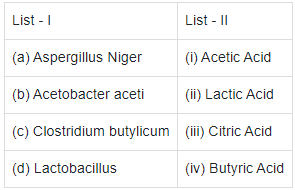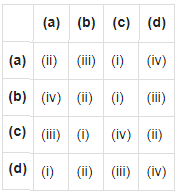31 Years NEET Previous Year Questions: Microbes in Human Welfare - NEET MCQ
30 Questions MCQ Test Biology 31 Years NEET Chapterwise Solved Papers - 31 Years NEET Previous Year Questions: Microbes in Human Welfare
Match List - I with List - II [NEET 2021]

Choose the correct answer from the options given below.


Choose the correct answer from the options given below.

Which of the following is put into Anaerobic sludge digester for further sewage treatment? [NEET 2020]
| 1 Crore+ students have signed up on EduRev. Have you? Download the App |
Which of the following can be used as a biocontrol agent in the treatment of plant disease? [NEET 2019]
Conversion of milk to curd improves its nutritional value by increasing the amount of [NEET 2018]
Which of the following in sewage treatment removes suspended solids? [NEET 2017]
Maximum nutritional diversity is found in the group.
[2012]
Which one of the following is an example of carrying out biological control of pests/ diseases using microbes ?
[2012]
A nitrogen-fixing microbe associated with Azolla in rice fields is :
[2012]
Yeast is used in the production of
[2012]
Which one of the following microbes forms symbiotic association with plants and helps them in their nutrition
[2012]
A patient brought to a hospital with myocardial infarction is normally immediately given :
[2012]
Monascus purpureus is a yeast used commercially in the production of :
[2012]
Which one of the following is a wrong matching of a microbe and its industrial product?
[2011M]
Which one of the following help in absorption of phosphorus from soil by plants?
[2011]
An organism used as a biofertilizer for raising soyabean crops is
[2011]
Which one of the following is not used in organic farming?
[2010]
The common nitrogen fixer in paddy fields is
[2010]
A common biocontrol agent for the control of plant diseases is
[2010]
Cryl endotoxins obtained from Bacillus thuringiensis are effective against
[2008]
Human insulin is being commercially produced from a transgenic species of
[2008]
Trichoderma harzianum has proved a useful microorganism for
[2008]
Probiotics are
[2007]
Two microbes found to be very useful in genetic engineering are
[2006]
Which of the following is pair of biofertilizers?
[2001]
The aquatic fern, which is an excellent biofertiliser is
[1999]
Farmers have reported over 50% higher yields of rice by using the biofertilizer
[1998]
Which one of the following is non-symbiotic biofertilizer?
[1998]
Gobar gas contains mainly
[1997]
Which of the following is likely to be achieved in the coming two decades?
[1997]
Which one thing is not true about antibiotics?
[1996]
|
33 docs|83 tests
|
|
33 docs|83 tests
|


















